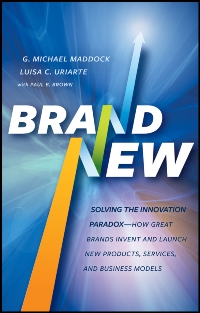Anatellô
Monthly Archive
Brand New : Book Review

The authors of Brand New have identified an ‘Innovation Paradox.’ Their research shows that the high failure rate of new product introductions (currently nine out of ten) has not improved in the last thirty years. What’s more, companies know innovation is important to share price and company performance, yet many accept they do not devote enough resources to it. Finally, they found that companies do not focus efforts on improving their innovation performance with the same zeal that they might focus on other under-performing aspects of their businesses.
The authors’ solution, perhaps understandably, as they are innovation consultants – is to suggest that companies bring in consultants who have an innovation PROCESS.
An effective process IS a key driver of success in innovation – there is plenty of research evidence to prove this. Brand New describes a sound innovation process and the authors write in a way that is accessible to a novice or a seasoned innovator. However, process alone is not enough for successful innovation - I will return to this later.
Innovation process to large companies often means something different from what it does to innovation consultants. Many big companies follow a Stage Gate process which typically emphasizes a defined number of stages of technical development. At the same time such a process enables innovation teams and senior management to monitor the levels of R&D and marketing investment and to update revenue forecasts for the new propositions as market knowledge increases.
A Customer-Focused Process.
By contrast, the process the Brand New team suggests, has a stronger emphasis in three areas : customer needs, ideas and communications.
Of course, there are many more aspects to consider in an innovation process than these three, but encouraging innovators to view these as the foundations of any innovation process is sound. Without them your innovation does not stand a chance.
Three of the early chapters of the book are devoted to these three topics, with exhortations to be clear about the customer need before generating ideas. There is also a persuasive case study about TIVO highlighting how important it is to refine your proposition until it is truly single-minded.
The book provides a good level of detail for the in-company innovator. There are helpful suggestions on the importance of market segmentation to innovation, and how involving experts and consumers can enrich the innovation process. Also the importance of breaking out of ‘company think’ about the market – what the authors call “getting out of the jar.”
There are some interesting frameworks; a fresh take on innovation portfolio management which is a bit richer than the often found risk/reward matrix. There’s also an effective evaluation checklist for the three suggested focus areas; insight, idea and communication.
Perhaps, in order to explain their innovation process clearly, and to demonstrate its effectiveness, the authors have made executing it appear more linear than any innovation process ever is. Inexperienced innovators who venture forth may be dismayed to find that all the pieces of the jigsaw, insights, ideas and customer segments often do not fit together as easily as the book might suggests. There is no mention made of how innovation is an iterative process, or of how insights and ideas have to be developed, crafted and refined with sequential inputs from consumers and the innovation team.
Innovation Process is Not Enough.
Likewise, I found the authors had little to say on the importance of the innovation attitudes and behaviours of the project team despite there being extensive evidence that these are key performance drivers of any innovation process.
I am talking here about both the innovation mindstates at the team and individual level and also about how the attitudes and values of senior management influence innovation outcomes sometimes far more than the process.
I feel that the process advocated by the authors is best suited for those looking to innovate in low tech, consumer goods markets which can be segmented relatively easily. It exhorts the innovator to find the ‘huge problem waiting to be solved’ which suggests an assumption that if you have the right process you will be able to find a large, clearly defined unmet need within your market that no other competitor has spotted. Indeed, lots of senior managers are waiting for their teams to dash into their offices with exactly this news.
However, as we know, in these days of market saturation, the opportunities are more likely to be found at the edges of markets, and where one market melds with another. This is where consumers find it harder to articulate their needs, indeed they may not know they have a need until a well-developed concept is presented to them. In such situations, propositions may research poorly. The risks and rewards of the whole project may be hard to evaluate – the launch/don’t launch decision may not be clear cut and then, wham! It launches and it takes off… or maybe it doesn’t. The point is, innovation even with a good process cannot be judged in the same way as managing current operations and I don’t think this book fully acknowledges that.
However, this process could really compliment an ‘internally focused’ Stage-Gate process. I think it could help teams to develop incremental and some differentiated innovations. However, due to its lack of focus on innovation culture I think it would be less likely to suffice when looking to develop disruptive or revolutionary innovations.
AnatellÔ score as a tool to assist with innovation and growth 3.5/5
Brand New by G. Michael Maddock, Luisa Uriarte and Paul Brown is published by Wiley 211p
© AnatellÔ Ltd 2012. All rights reserved.




Comments
Post new comment